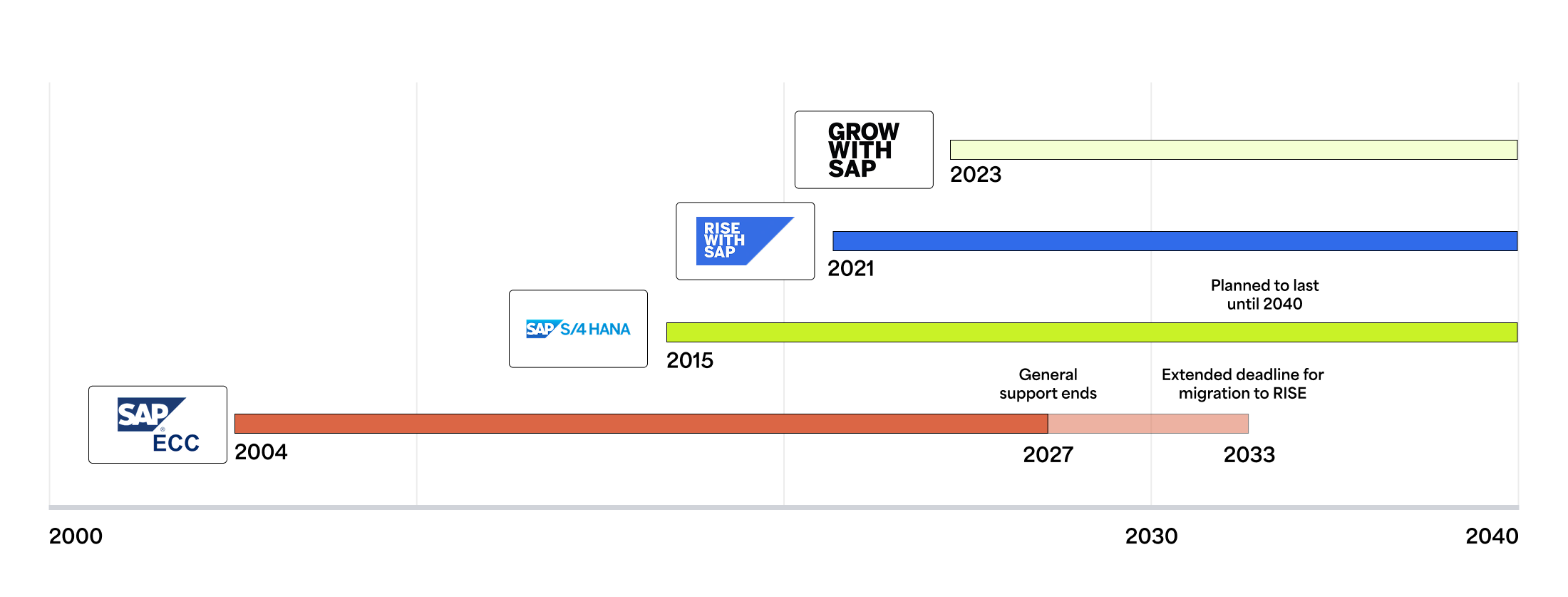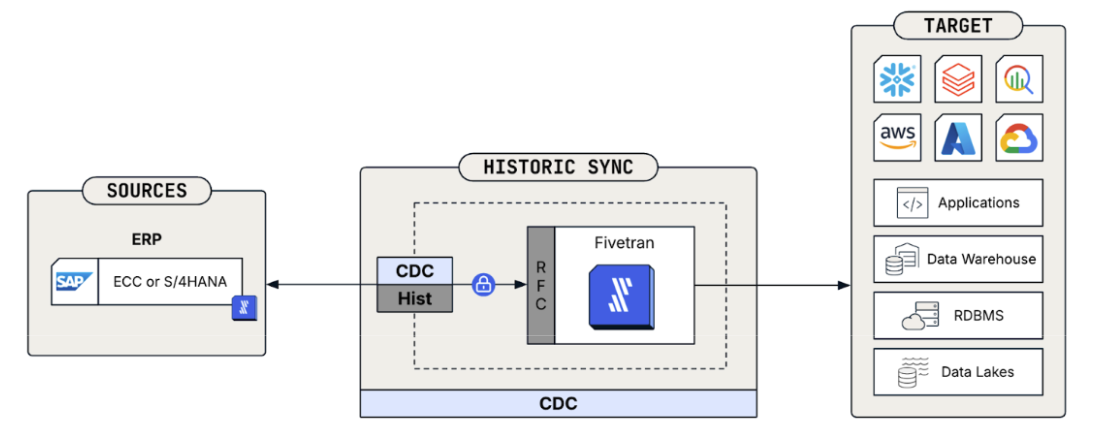SAP-Kunden investieren in großem Umfang in Enterprise-Software und -infrastruktur und erwarten dabei sowohl hohe Leistung als auch betriebliche Flexibilität. Die Geschäftsstrategie, die Lizenzmodelle und die Ökosystem-Architektur von SAP brachten jedoch neue Einschränkungen mit sich, insbesondere was den Datenzugriff und die Interoperabilität betrifft.
Im vorigen Teil dieser Serie haben wir untersucht, wie die sich weiterentwickelnden SAP-Richtlinien die geschäftliche Agilität einschränken, indem sie das Data Movement begrenzen. Diesmal befassen wir uns mit praktischen Überlegungen für SAP-Kunden, die diese Einschränkungen umgehen wollen, und wie sie dies tun können, ohne die Einhaltung von Vorschriften oder die Leistung zu beeinträchtigen.
Zunächst ist es wichtig zu erkennen, dass ERP-Daten äußerst wertvoll sind, wenn sie extrahiert und mit anderen geschäftskritischen Datenquellen wie CRM-Daten, unstrukturierten Daten, Datenbankdaten oder anderen wichtigen Daten kombiniert werden. Angesichts der großen Anzahl von Datenquellen in einem Unternehmen sind Datenteams jedoch die Hände gebunden, wenn sie nicht über die technischen Möglichkeiten verfügen, Daten aus all diesen Quellen zu aggregieren, und so sie nicht in der Lage sind, aussagekräftige Erkenntnisse, Berichte oder Fortschritte bei KI-Initiativen zu liefern.
Zweitens: Auch wenn die Support-Mitteilungen und Richtlinien von SAP rigide erscheinen mögen, haben Kunden oft mehr Möglichkeiten als angenommen. Eine gründliche rechtliche und technische Prüfung kann diese Möglichkeiten aufzeigen und ein Unternehmen in die Lage versetzen, seine eigenen Daten zu kontrollieren und zu mobilisieren.
Unabhängig davon, wo die Daten gespeichert sind – ob in einer von SAP gehosteten Infrastruktur oder auf einer Datenplattform eines Drittanbieters – die Daten bleiben Eigentum des Kunden. Unternehmen und Datenteams sollten sich im Stande fühlen, dieses Recht geltend zu machen.
Ein Überblick der ERP-Systeme von SAP

SAP ECC (ERP Central Component) ist seit langem das Rückgrat vieler Unternehmen und integriert die Unternehmensfunktionen der SAP-Anwendungssuite. ECC ist ein veraltetes System, das sich nur schwer skalieren lässt und nur eingeschränkt mit Tools von Drittanbietern funktioniert, sodass Kunden davor zurückschrecken, Daten zu extrahieren, um keine Ausfälle zu riskieren. ECC auf SQL Server, Oracle und HANA wird bis Ende 2027 unterstützt, mit optionaler Unterstützung bis 2033, wenn sich Kunden zur Migration auf RISE verpflichten. Einige der Datenrisiken dabei umfassen:
- Komplexe Datenstrukturen und Anpassungen: Proprietäre Datenformate machen die Extraktion komplex und teuer.
- Nicht unterstützte Legacy-Technologie: Ältere Datenbanken, Plattformen oder SAP-Middleware machen die Integration mit modernen Tools unnötig schwierig.
- Cluster-, Text- und Pool-Tabellen: Die meisten Replikationstools unterstützen diese komplexen SAP-Datentypen nicht.
- Überlastete Quellsysteme: Vor allem in Legacy-SAP-Umgebungen sind die Systeme oft ausgelastet, sodass die Administratoren zögern, neue Extraktions-Workloads hinzuzufügen, ohne zuvor die bestehenden zu entfernen.
SAP-Kunden, die nicht mit SAP ECC arbeiten, nutzen wahrscheinlich SAP S/4HANA, eine ERP-Suite der nächsten Generation, die 2015 exklusiv für die In-Memory-Datenbank HANA von SAP entwickelt wurde. S/4HANA bringt seine eigenen Herausforderungen für die Datenintegration mit sich, darunter:
- Lizenzierungsmodelle: Mit der Veröffentlichung von S/4HANA wurde der Unterschied zwischen Laufzeit- und Unternehmenslizenzen verschärft. SAP gewährt nur Kunden mit einer Unternehmenslizenz direkten Zugriff auf ihre Datenbank, was oft ein Mehrfaches einer Laufzeitlizenz kostet.
- Eingeschränkte Abwärtskompatibilität: ECC-Anpassungen müssen möglicherweise für S/4HANA überarbeitet werden, was Migrationen teuer und zeitaufwändig macht.
Das neueste Angebot von SAP, SAP RISE, bietet „Business Transformation-As-A-Service“. Es wurde entwickelt, um die digitale Transformation durch einen Managed Service für die Migration zu SAP S/4HANA auf einer Cloud-Infrastruktur zu beschleunigen. RISE reduziert die Kontrolle der Kunden über ihre ERP-Umgebung durch folgende Mechanismen:
- Begrenzte Flexibilität und Einschränkungen beim Cloud-Hosting: Die gesamte Umgebung (ERP, Infrastruktur und technische Dienste) wird von SAP gehostet, was die Verwendung von Datenextraktionstools von Drittanbietern oder den Wechsel zu einem anderen ERP-System erschwert. Insbesondere RISE-Kunden haben keine direkte Kontrolle über ihre Cloud-Infrastruktur und sind mit begrenzten Verbindungsoptionen konfrontiert. Für den Zugriff auf die Datenbank ist außerdem eine zusätzliche Gebühr in Form einer Unternehmenslizenz erforderlich.
- Undurchsichtige Preisgestaltung: SAP stellt keine klare Kostenaufschlüsselung für RISE zur Verfügung, sodass es für Kunden schwierig ist, die Kosten mit alternativen Lösungen zu vergleichen.
Mit RISE wird SAP von einem Softwareanbieter zu einem Cloud-Service-Anbieter, der seinen Einfluss auf die Kunden verstärkt, indem er sowohl die ERP-Software als auch die zugrunde liegende Infrastruktur kontrolliert. Kunden haben weniger Möglichkeiten und weniger Kontrolle, zumal die sich ändernden Regeln und Richtlinien von SAP zu Unsicherheit darüber führen, was in Bezug auf Datenintegration und -zugriff erlaubt ist, wie die zunehmend restriktiven Aktualisierungen von SAP-Mitteilung 2971304 zeigen.
Unabhängig von Ihrem SAP-ERP-System ist Fivetran in der Lage, Ihr Unternehmen bei der Zentralisierung von Daten zu unterstützen.
Fivetran:Eine Plattform bewegt die Daten dieser Welt
Fivetran vereinfacht die Datenreplikation aus SAP und über 700 anderen Quellen, einschließlich Datenbanken (SQL Server, Postgres), SaaS-Anwendungen (Salesforce, Google Ads), Ereignissen und Dateien in Data Lakes und Data Warehouses wie Snowflake, Databricks, Google Cloud Platform, S3 und mehr. Fivetran unterstützt Workloads und Architekturen, die Cloud-, Hybrid- und On-Premises-Systeme umfassen. Unternehmen können Daten mühelos in diese modernen Data Warehouses/Data Lakes verschieben und so erweiterte Analysen, maschinelles Lernen und KI-Initiativen ermöglichen.
SAP-Replikation mit Fivetran – Wie es funktioniert:
Fivetran führt die periodische Datenextraktion über eine SAP-RFC-Verbindung (Remote Function Call) aus, die SAP seit Jahrzehnten für die Integration von Drittanbietern zur Verfügung stellt. Dieser RFC bildet eine Schnittstelle zu einer Fivetran SAP Function Module-Komponente innerhalb der NetWeaver Anwendung von SAP, der sogenannten Fivetran NetWeaver API. Diese Komponente:
- Sammelt und verarbeitet geänderte Daten mit Hilfe von Change Pointern in den SAP-Systemen und Triggern auf Tabellen, wodurch zusätzlicher Overhead auf dem Daten-Backend von SAP begrenzt wird
- Validiert und komprimiert Daten für eine optimierte Übertragung und optimiert so die Nutzung der verfügbaren Netzwerkkapazität
Die NetWeaver-API ist von Fivetran in Form einer herunterladbaren SAP-Transportdatei verfügbar. Dieser Transport funktioniert wie jede andere benutzerdefinierte ABAP-Erweiterung innerhalb von SAP (erfordert SAP NetWeaver 7.5 oder höher) und kann von Anwendungsadministratoren über das SAP-Standard-Transportmanagementsystem importiert werden. Bei diesem Ansatz verbindet sich Fivetran direkt mit der SAP-Anwendung und verwendet dabei die integrierten Standardmethoden von NetWeaver. Da Fivetran über die Anwendungs-Layer arbeitet, ist es dem SAP-System möglich, den Datenzugriff, die Autorisierung und das Prozessmanagement zu verwalten.
Fivetran liefert SAP-Daten auf sichere Weise an einen Data Lake oder ein Data Warehouse nach Wahl des Kunden. Dazu wird eine sichere Verbindung mit SAP-Quellen auf verschiedene Arten hergestellt, einschließlich VPN, SSH, Private Link und SAP SNC. Für zusätzliche Flexibilität sorgt Hybrid Deployment von Fivetran, die SAP-Daten nahtlos integriert und gleichzeitig vollständig in einer sicheren Umgebung verarbeitet.
Kurz gesagt: Der SAP-Konnektor von Fivetran wurde entwickelt, um Daten aus SAP-Systemen zu integrieren, ohne auf SAP-Middleware zurückzugreifen oder unnötige Komplexität zu schaffen. Er bleibt aus folgenden Gründen eine praktische Wahl für Unternehmen:
- Die Verbindung erfolgt über SAP NetWeaver: Die Lösung von Fivetran stützt sich bei der Datenextraktion ausschließlich auf die Standard-NetWeaver-Anwendungs-Layer von SAP. Das bedeutet, dass der Konnektor sowohl mit Unternehmens- als auch mit Laufzeit-HANA-Umgebungen funktioniert, einschließlich SAP-Systemen, die in RISE Private eingesetzt werden. Für ECC-Kunden stellt Fivetran die Verbindung über das Standard-RFC-Protokoll her, für ECC-Kunden mit einer Unternehmenslizenz kann Fivetran jedoch auch direkt mit der zugrunde liegenden Datenbank (Oracle oder SQL Server) verbunden werden. Fivetran unterstützt auch SAP OData und ermöglicht die Replikation von SAP RISE Public und SAP GROW.
- Keine Abhängigkeit vom SAP ODP-Framework: Eine SAP-Mitteilung von 2024 verbietet die Verwendung von ODP (Operational Data Provisioning) über RFC. Die Lösung von Fivetran verwendet jedoch nicht das ODP-Framework und ist von der Umstellung durch SAP nicht betroffen.
- Funktioniert unabhängig vom Zertifizierungsprogramm von SAP: Die Richtlinien von SAP verbieten die Zertifizierung von ELT-Lösungen und empfehlen stattdessen SAP Datasphere für ELT. Dennoch bleibt der Ansatz von Fivetran vollständig kompatibel und ermöglicht es den Kunden, die Lösung zu wählen, die ihren Anforderungen an die Datenintegration am besten entspricht. SAP-Kunden können Fivetran weiterhin nutzen, um SAP-Daten zuverlässig und sicher zu integrieren.
- Unterstützung für SAP-Datentypen und -Tabellen: Fivetran unterstützt Langtext, die Umwandlung von SAP-Daten, das Laden von CDS-Ansichten und die SAP-Archivierung.
- Garantiert 99,9 % Uptime: Das Service Level Agreement (SLA) von Fivetran garantiert die Uptime der Kerndienste und die Verfügbarkeit der Daten mit professionellen Dienstleistungen und Support. Unser globales Team umfasst Experten mit SAP-Kenntnissen, die rund um die Uhr bei der Behebung von Problemen helfen und eine reibungslose, zuverlässige Datenintegration gewährleisten.

Durch die Befreiung von SAP-Daten erhalten Kunden die Kontrolle zurück und können Ressourcen sparen
Die vollständig verwalteten Datenpipelines von Fivetran helfen Unternehmen, die vollständige Kontrolle über ihre SAP- und Nicht-SAP-Daten zu behalten, ohne an das SAP-Ökosystem gebunden zu sein. Durch die Vereinheitlichung von Daten aus dem gesamten Unternehmen können Unternehmen eine erstklassige Datenarchitektur aufbauen, die fortschrittliche Analysen, Geschäftsprozessautomatisierung und KI/ML-Initiativen unterstützt. Fivetran macht auch kostspielige Workarounds überflüssig, die durch die Extraktionsbeschränkungen von SAP verursacht werden, und ermöglicht schnellere Innovationen durch die nahtlose Integration von SAP-Daten (z. B. aus Finanzen und Lieferkette) mit CRM-, Web- und Drittquellen. Dies ermöglicht leistungsstarke Anwendungsfälle wie vorausschauende Prognosen, Bestandsoptimierung in Echtzeit und KI-gesteuerte Customer Insights.
In einer IDC-Studie wurde festgestellt, dass Fivetran-Kunden durch den Einsatz von Fivetran jährliche Vorteile im Wert von durchschnittlich 1,5 Millionen Dollar erzielten:
- Erhebliche Steigerung der Produktivität von Datenteams durch die Automatisierung hochgradig manueller Aufgaben wie dem Aufbau und Pflege von Pipelines, den Umgang mit Schema Drift und verbesserten Zugang zu hochwertigen Daten
- Steigerung der Umsatzchancen im Unternehmen durch die Erschließung von Daten für einen besseren Kundenservice und bessere strategische Planung
Tatsächlich sparten die befragten Fivetran-Kunden im Durchschnitt über 175.000 $ pro Jahr an Betriebskosten.
Übernehmen Sie mit Fivetran die Kontrolle über Ihre SAP-Daten
SAP-Kunden erwarten zu Recht Klarheit, Flexibilität und Kontrolle, wenn es um ihre Daten geht, und Datenteams brauchen diese Flexibilität und Kontrolle, um ihre Arbeit effektiv zu erledigen und überzeugende Datenergebnisse zu erzielen. Das SAP-Ökosystem ist zunehmend von Vorschriften geprägt, weshalb ein Verständnis der verfügbaren technischen und vertraglichen Hebel entscheidend ist, um die Autonomie zu erhalten und den Wert von ERP-Investitionen zu steigern.
Aber verlassen Sie sich nicht nur auf unser Wort. Im nächsten Teil unserer SAP-Serie zeigen wir Ihnen, wie globale Unternehmen Fivetran nutzen, um die Extraktion, Replikation und Zentralisierung ihrer SAP-Daten zu automatisieren, Echtzeit-Erkenntnisse zu gewinnen und Innovationen in ihrem Unternehmen zu beschleunigen.
[CTA_MODULE]
.jpg)
.png)











